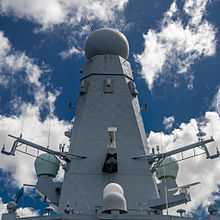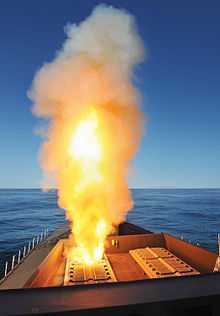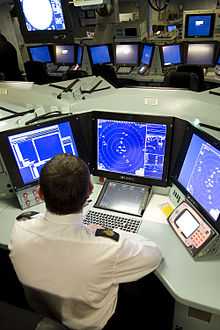PAAMS

The Principal Anti Air Missile System (PAAMS) is a joint programme developed by France, Italy and the United Kingdom for an integrated anti-aircraft warfare system. The prime contractor is EUROPAAMS, a joint venture between Eurosam (66%) and MBDA subsidiary UKAMS (33%). MBDA also owns 66% of Eurosam, in effect giving it a 77% share of the project. In the United Kingdom PAAMS has been given the designation Sea Viper.[1]
The PAAMS warfare system is in service with the Royal Navy, French Navy and the Italian Navy.
Background


PAAMS was originally intended to be deployed in the 'Common New Generation Frigate' (also known as the Horizon-class frigate) for the navies of the United Kingdom, France and Italy.[2] The French DGA placed a contract with EUROPAAMS on 11 August 1999 for the development production of the PAAMS warfare system along with the associated Long Range Radar (LRR) system. The contract included including one PAAMS system and one LRR for each of the first British, French and Italian new class of warships. However irreconcilable differences in the design requirements led to the United Kingdom leaving the 'Common New Generation Frigate' project in October 1999. After withdrawing, Britain instead decided to pursue a national warship design, designated the 'Type 45 Destroyer'. The United Kingdom remained committed to the PAAMS project.[3] As a result of efforts to achieve economies of scale, the PAAMS command systems shares common architecture between the Horizon-class and Type 45 destroyers. On 28 January 2009, the PAAMS was given its official designation of Sea Viper by the Royal Navy.[1]
PAAMS components
- PAAMS (S) — British variant with SAMPSON Multi-Function Radar (MFR)
- PAAMS (E) — French/Italian variant with EMPAR Multi-Function Radar
- Automatic Command and control system
- Consoles running Windows 2000 operating system
- SYLVER vertical missile launcher
- MBDA Aster missiles
- Aster 15 - Short to medium range
- Aster 30 - Medium to long range
Both variants of the PAAMS operate in conjunction with the S1850M Long Range Early Warning Radar.
Capabilities
PAAMS is designed to track, target and destroy a variety of high performance air threats, including saturation attacks of very low altitude (sea skimming), supersonic cruise missiles, fighter aircraft and UAVs. PAAMS, with its Sylver Vertical Launching System, can launch 8 missiles in under 10 seconds while simultaneously guiding up-to 16 missiles to designated targets at any one time.[4] The British PAAMS(S) variant consists of both the SAMPSON and S1850M long range radars and capable of tracking in excess of 1,000 targets at ranges of up-to 400 km. BAE Systems also claim its SAMPSON radar has "excellent detection of stealth aircraft and missiles".[5]
Nick Brown the editor-in-chief of Jane’s International Defence Review was quoted by The Huffington Post (a US online news aggregator and blog) saying, "It’s [Type 45 destroyer] certainly one of the most advanced air defence ships in the world... The US Aegis system is similar, but Sea Viper (PAAMS) is more advanced."[6]
Testing

- During its first major warfare sea exercise aboard HMS Daring the ship's Combat Management System crashed while under simulated air attack due to a power failure and the ship lost use of its combat management system; the ship's crew reverted to use of binoculars to spot incoming airborne threats until the CMS had been restarted.[7]
- In 2009, two test firings of PAAMS in the British configuration from the Longbow trials barge failed due to "failures in the terminal phase of the engagement." It was believed that "production weaknesses" in a batch of Aster 30 missiles imported from France were to blame.[8]
- In September 2010, off the Outer Hebrides at the Benbecula ranges, HMS Dauntless (D33) was the first Royal Navy Type 45 destroyer to successfully shoot an Aster missile and proceed to intercept its target. The target was a Mirach drone. Mirach is a 13 ft jet which flies at speeds of up to of 530kts (more than 600 mph) from altitudes as low as 10 ft or as high as 40,000 ft.[9]
- In May 2011, HMS Daring (D32) the first of the class of the Royal Navys Type 45 destroyers successfully fired its Aster missiles for the first time. The shoot took place off the Outer Hebrides at the Benbecula ranges in Scotland. Daring intercepted and destroyed its target, a Mirach drone.[10]
- In April 2012, the French Navy successfully shot and downed an American GQM-163 Coyote target. The GQM-163 Coyote was simulating a sea-skimming supersonic anti-ship cruise missile traveling at speeds of Mach 2.5 (3000 km/h) with an altitude of less than 5 metres. The Aster 30 missile was fired by the Horizon class frigate Forbin (D620), also present during the shoot was Forbin's sister ship Chevalier Paul (D621). The successful shooting represents the first time a European missile defence system has intercepted and destroyed a supersonic sea-skimming "missile". The trial was described as a "complex operational scenario".[11]
- In May 2012, HMS Diamond (D34) was the third Royal Navy Type 45 destroyer to successfully intercept its target with an Aster missile. The firing took place off the Outer Hebrides at the Benbecula ranges in Scotland.[12][13]
- In July 2012, HMS Dragon (D35) was the fourth Royal Navy Type 45 destroyer to successfully intercept its target with an Aster missile. The firing took place off the Outer Hebrides at the Benbecula ranges in Scotland. Dragon's Operations Officer, Lieutenant Commander Duncan MacRae, of the Royal Australian Navy said: "This was a great demonstration of the capability of a Type 45 and a reassurance of system performance."[14]
Applications

United Kingdom
- Type 45 destroyers - six ships
France
- Horizon-class frigates - two ships
Italy
![]() Marina Militare
Marina Militare
- Horizon-class frigates - two ships
See also
References
- ↑ 1.0 1.1 "Who dares wins - Royal Navy's newest warship arrives at her Portsmouth home" (Press release). BVT Surface Fleet. 28 January 2009. Retrieved 2009-01-28.
- ↑ Nicoll, Alexander (1999-04-27). "National differences scupper frigate project". Financial Times.
- ↑ "Sampson flexes its muscles". Electronics Times. 1999-06-07.
- ↑ Eurosam: Naval Systems - Aster 15 & 30/PAAMS (Official Eurosam website), Retrieved February 2014.
- ↑ BAE Systems: SAMPSON MULTI FUNCTION RADAR (Download PDF) Retrieved 18 February 2014.
- ↑ HMS Dauntless, The Royal Navy's 'Cutting Edge' Deterrent
- ↑ Channel4 Documentary first broadcast Monday 31 May 2010
- ↑ Barrie, Douglas (2010-05-07). "MBDA Prepares For Further Sea Viper Testing". Aerospace Daily & Defense Report.
- ↑ Royal Navy - Sea Viper
- ↑ MOD - HMS Daring fires Sea Viper for first time, 19 May 2011.
- ↑ Interception d’une cible supersonique évoluant au ras de l’eau. (In French)
- ↑ MOD - HMS Diamond fires Sea Viper missile for first time, 1 May 2012.
- ↑ Diamond fires her main weapon for the first time, 1 May 2012.
- ↑ HMS Dragon spits Sea Viper fire
External links
- Navy Matters on PAAMS
- UK's Parliamentary Defence Select Committee: Session 2001/02 Update on weapons programmes.
- UK's Parliamentary Defence Select Committee: Session 2002/03 Update on Type 45, PAAMS, and other surface ships.